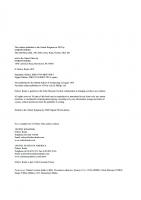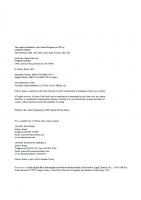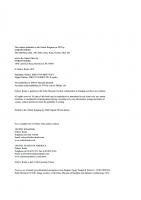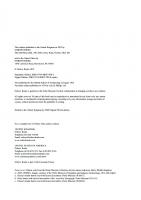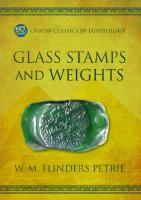Corpus of Prehistoric Pottery and Palettes (Oxbow Classics in Egyptology) 9798888570180, 9798888570197
199 62 29MB
English Pages [70]
Cover
Book Title
Copyright
PREFACE TO THE 2023 EDITION
PUBLISHER’S PREFACE
THE CORPUS OF PREHISTORIC POTTERY
THE CORPUS OF SLATE PALETIES
THE REGISTERS
Backcover
Recommend Papers

- Author / Uploaded
- Sir W.M. Flinders Petrie
File loading please wait...
Citation preview
Oxford & Philadelphia
This edition published in the United Kingdom in 2023 by OXBOW BOOKS The Old Music Hall, 106–108 Cowley Road, Oxford, OX4 1JE and in the United States by OXBOW BOOKS 1950 Lawrence Road, Havertown, PA 19083 © Oxbow Books 2023 Paperback Edition: ISBN 979-8-88857-018-0 Digital Edition: ISBN 979-8-88857-019-7 (epub) First published by the British School of Archaeology in Egypt, 1921 Facsimile edition published in 1974 by Aris & Phillips Ltd Oxbow Books is grateful to the Petrie Museum for their collaboration in bringing out these new editions All rights reserved. No part of this book may be reproduced or transmitted in any form or by any means, electronic or mechanical including photocopying, recording or by any information storage and retrieval system, without permission from the publisher in writing.
Printed in the United Kingdom by Short Run Press, Exeter
For a complete list of Oxbow titles, please contact: United Kingdom Oxbow Books Telephone (0)1226 734350 Email: [email protected] www.oxbowbooks.com United States of America Oxbow Books Telephone (610) 853-9131, Fax (610) 853-9146 Email: [email protected] www.casemateacademic.com/oxbow Oxbow Books is part of the Casemate Group
Front cover: Caliciform pottery vessel with incised decoration. Purchased by Flinders Petrie at Luxor, possibly Naqada II Period (c. 3500–3200 BC). Petrie Museum UC17869. Image courtesy of the Petrie Museum of Egyptian and Sudanese Archaeology, UCL.
PREFACE TO THE 2023 EDITION In the 1970s, a much-anticipated new series of publications illustrated objects and themes related to the excavations of the archaeologist William Matthew Flinders Petrie (1853–1942) in Egypt, and aspects of the collection of University College London’s Petrie Museum of Egyptian and Sudanese Archaeology. A young couple setting up in business in the early 1970s, Aris and Phillips published these works, written by members of the UCL Egyptology Department, in their Modern Egyptology series. Building on Petrie’s own observations, the authors of these volumes aimed to complete the great task of publishing the Petrie Museum of Egyptian and Sudanese Archaeology’s vast collection, and to present some of the research that Petrie himself was not able to address in his own published works during his lifetime. As the current Curator of the Petrie Museum, it is a great privilege for me to support Oxbow Books in their mission to republish the series, which remains a key source of information for all those interested in object-based approaches to the study of the ancient world. The Petrie Museum, part of University College London (UCL), is home to one of the largest and most significant collections of Egyptian and Sudanese archaeology in the world. Free to visit, this extraordinary collection tells stories about the lives of ordinary people who lived along the Nile Valley thousands of years ago. Originally set up as a teaching collection, the Petrie Museum comprises over 80,000 objects housed together with an internationally important archaeological archive. It is a collection of world firsts and ‘oldests’: the oldest woven garment; the oldest worked iron objects; the first known depiction of loom weaving; the oldest known written document about women’s health; the earliest veterinary treatise; the oldest will on paper. The Museum has Designated Status from Arts Council England, meaning that it is considered to have outstanding resonance and national cultural significance. The collection has a substantial, visible international reputation for research, supporting hundreds of researchers every year, both remotely and in person. The Petrie Museum is named after Flinders Petrie, who was appointed in 1892 as the first Professor of Egyptian Archaeology and Philology in the UK at UCL. Over three-quarters of the material in the Museum comes from excavations directed or funded by Petrie, or from purchases he made for university teaching. In 1880 at
the age of 26, Petrie travelled to Egypt to survey the Great Pyramid. For the next five decades he was at the forefront of the development of archaeology in Egypt and later in Palestine, and his detailed methodological approach continues to shape the discipline today. Petrie worked at more sites, with greater speed, than any modern archaeologist: seeing his life as a mission of rescue archaeology, Petrie aimed to retrieve as much information as possible from sites that were shrinking dramatically in size as Egypt modernised during the late 19th and early 20th centuries. He published a large part, but not all, of the finds from his excavations in his illustrated typological volumes, arranged according to object types and themes. Today, much of the Petrie Museum’s collection is displayed and stored in a way which reflects these publications: for example, several storage cupboards are dedicated to the material illustrated in the ‘Objects of Daily Use’ volume, and objects in the drawers are arranged according to the order of the published plates. This offers a unique opportunity for researchers to engage with Petrie’s typological and methodical approach to archaeology, as well as with the history of museum collections. The first catalogue to be published in the Modern Egyptology series was Amarna: City of Akhenaten and Nefertiti in 1972 by Julia Samson, Petrie Museum Honorary Research Assistant. As official publishers to the UCL Egyptology Department the series went on to produce facsimile reprints of eight of Flinders Petrie’s most important site reports and many of his object catalogues, originally published through the British School of Archaeology in Egypt. The substantial annual royalties from these reprints were paid into the ‘Petrie Fund’ at the time, which provided special grants to students in financial need. In many ways, the new reprints of this classic series can be seen as the latest layer in a vast ‘publication stratigraphy’ of the thousands of finds from Flinders Petrie’s excavations, which now live in museum collections around the world. On reading these volumes, I hope that readers will also be inspired to learn more about the Petrie Museum collection and its fascinating history. Dr Anna Garnett Petrie Museum of Egyptian and Sudanese Archaeology, University College London January 2023 iii
PUBLISHER’S PREFACE Oxbow Books is pleased to present this title in our Classics in Egyptology series. This series of facsimile re-issues is comprised of two sub-series. The first consists of 16 typological catalogues produced by W.M. Flinders Petrie based on his massive collection of Egyptian artefacts. Mostly excavated by Petrie during many seasons of campaign in the last years of the 19th and early decades of the 20th century, they now reside in the Petrie Museum at University College London. Published between 1898 and 1937 and long out of print, the catalogues were re-issued in facsimile by publishers Aris and Phillips in the 1970s. These were followed in the next 15 years or so by publication of a number of newly commissioned titles, based on more recent examination of elements of the Petrie Collection by contemporary experts, under the name Modern Egyptology. A selection of these additional titles forms the second component of our own series. The archaeology of Egypt continues to fascinate. Multi-disciplinary investigation and research continues unabated, encompassing methodologies, scientific and data processing techniques, theoretical approaches, and even whole paradigms that were unheard of in the 1970s and undreamt of when Petrie was working in Egypt. Yet all the titles included in this series continue to be invaluable sources of basic data, providing an unparalleled resource that can easily be cross- referenced with the actual materials they describe and discuss. They remain within the Petrie Collection where they may be accessed and re-examined as new research flourishes. As historic documents, the Petrie
iv
catalogues stand as exemplars of the craft of typological classification, the backbone of modern archaeology – much of which, though refined by absolute dating and another 100 years of research, still stands the test of time.
A note on presentation The facsimile titles of Petrie’s catalogues re-issued in the 1970s were produced from scans of the original publications. Scanning technology at that time was not of the standard or resolution of today. The scans are no longer available, nor has it been possible to obtain, and in doing so destroy, original copies of the Petrie catalogues. These titles have therefore, of necessity, been rescanned from the 1970s re-issues. Where necessary the pages have been digitally enhanced for clarity of reading and to ensure the good quality of the plates, though inevitably a few are not of the standard we might wish, because of the quality of the previous scan, and occasional blocks of text are not precisely ‘straight’ or evenly situated on the page. However, some pages in the 1970s re-issues had been inserted in the wrong order and this has been corrected. The originals were produced at a folio size. The pages have been reduced slightly to standard A4 for ease of shelving and because this has the effect of slightly improving the scanned images. In some cases, illustrations were presented to scale and the original scale is given on the plate. There were also no digital files available for titles included in the Modern Egyptology series, so these too have been scanned from printed copies.
THE CORPUS OF PREHISTORIC POTTERY IT is hardly needful, after the discussion of the dating in the previous volume on Prehistoric Egypt, to describe the present corpus, or the mode of using it. It contains all the forms published in the various works enumerated at the beginning of the volume named, unified as a whole and provided with sequence date·s. The practical use of it is by the graveside. So soon as a grave is cleared and planned, then the pottery can be laid out in order, each type searched for in the corpus, and noted by its letter and number on the card register. The limits of date can be copied out, and the resulting limits of the date of the grave may then be added as the date on the card. Such pottery as is worth removal, and especially any new type that should be drawn, can then be separated, and the remainder of common pottery be returned to the grave and covered in. In unifying the various additions-some 700which have been found since the 300 types of Naqada, many irregularities have been noticed, and some editing of the whole became absolutely necessary. Even different types had been given the same letter by different discoverers. In the Decorated pottery especially, the additions had made a complete revision of types I to 19 needful. In this part, therefore, the present corpus makes an entire break with the previous registers. Some other slight changes became -.eedful also in other classes, but the minimum of change has been made. All of these alterations of designation are completely stated on pI. lx, under the heading of each volume in which a type has previously appeared. On the same plate are conversion tables for reducing Reisner's short corpus used in Nubia, to the present corpus numbers. Every change therefore between. this corpus and previous registers is on pI. Ix. The changes of numbers from the previous English publications, were mostly due to those who made
additions not recognising the principles of arrangement. Such principles may be arbitrary, but yet they must be kept up, or else a corpus would become so confused that identification of forms would be difficult. The principles which must be observed in all additions to the corpus are as follow: I. The forms are chiefly classed from the most open, such as shallow saucers, to the most closed, such as bottles. In carrying this out, the bowls are classed by the slope of the edge,-the most open, the most sloping, the almost upright, the vertical and the different degrees of incurving. Another criterion is the proportion of height to width; some large classes of vases are divided into those under or over certain proportions. In some cases obvious inversions of order occur, because some types continue to vary to a great extent, and after tracing out that line, a turning back to some other type has to be made. The indefinite variation over so large a number of features, makes any single-line order necessarily illogical. All that can be hoped for is to arrange the types so that they can be searched for in the shortest time. In all additions the principle of arrangement must first be observed before inserting a new form. 2. Another confusion has been caused by not noticing what is included in an established class, such as the black polished pottery in F class. Additions to this have been made into a new class, but are here restored to F. 3. A needless multiplication of new types has been made, when the differences from established types were but slight or imperceptible. Variations should be ignored when they are within the chances of copying; the two sides of a jar often differ perceptibly, and such slight differences are immaterial. Strictly, no vase is perfectly like another, and we must put together all those which
THE CORPUS OF SLATE PALETIES R. T.
THE plates of slates in Naqada were merely a catalogue of the forms found, without framing a regular corpus or excluding duplicate forms. Since that was issued many more forms have been registered, and some unification of the whole is necessary. The present corpus includes all the types that have been published in recent works. The references ate :
T. II. U.
W.G.
Reisner, A.S. of Nubia. Tarkhan. Tark,han II. Hu (Diospolis) references, not drawn separately. Wainwright, Gerzeh.
The tC? right number and letter is the type. The bottom left reference is the source, according to the letters just stated. The figures at the bottom right are the Sequence Dates; where several are known for a type, the earliest and latest are quoted, and the best defined are selected. The inclusion of so many new forms has made it necessary to adopt fresh numbers for this final corpus, mostly rather different from the mere catalogue numbers used in Naqada.
Plain numbers, Naqadeh graves. A. El Amrah, and cemeteries b, c. C.A.I. Cemeteries of A bydos I. D. Diospolis. F. Firth, A. S. of Nubia. G.W. Gerzeh, Wainwright. M. Mahasna, Ayrton and Loat. N. Naqada; with B or T, cemeteries.
THE REGISTERS number of grave. Also a list of the sources of the type drawings of white Cross-lined pottery, with sequence dates when known; and the same for Black-incised pottery. Below are references to a few more types, so far as they can be distinguished in the photographs of Mahasl1a, by Ayrton and Loat, and four copies of the unusual types. The curved spray in 498 is unique; the figures of women with a fringe girdle in lOa K are very rare; the vase with animals along the length of it, is unique; and the hippopotamus hunt is very rare, see type 5 m.
ON pI. xl are given the corpus equivalents of the numbers used by Dr. Reisner in the first volume of the Archaeological Survey of Nubia, 1907-8: these were abandoned in the succeeding volumes: also the alterations which have proved to be necessary in unifying all the corpus numbers of many publications. All these registers are needed when referring to previous works. On pI. lxi is a list of the pottery types in University College, with reference to their sources when known: D, Diospolis; Gerz., Gerzeh; N, Naqada, with
7
